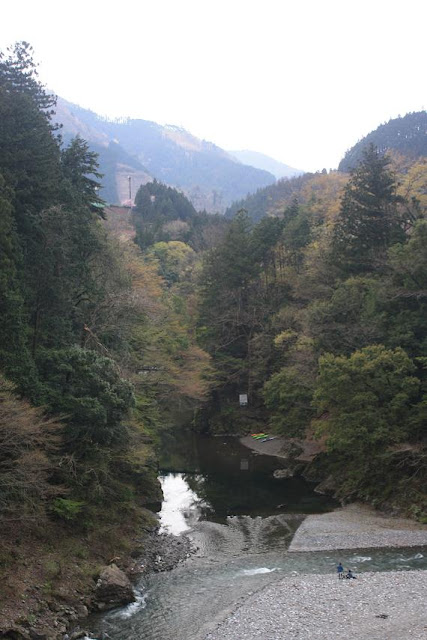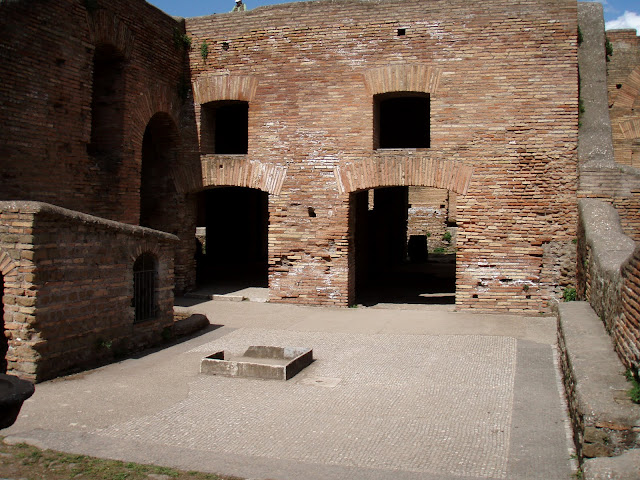After my last effort to do this day walk near Tokyo I was mindful of the effect that the weather may have on the area. I woke at 4 am on Saturday to the sound of hail and snow and decided that it would be best to wait until Sunday to do the walk. It turns out that the snow that fell on Friday night was the first April snow in Tokyo for over 30 years.
After my initial attempt at this walk I did some further reading and one of the things that struck me was that this walk traversed 3 of Japan's top 200 “best mountains”.
I rose early on Sunday and started the 3 hour journey to the mountains. While travelling there I was a little concerned that the weather would not clear but when I arrived at the top of the cable car I had a great view back toward Tokyo.
The beginning of this walk takes you through Mitake town where some of the buildings still have traditional thatch and shingle roofs.
Even though it was relatively early in the morning the shop keepers on the way to Mitake shrine were open and trying to entice travellers into their restaurants to partake of raman.
When I finally managed to make it out the town and started walking proper it became apparent that even though the snow had melted at the lower altitudes it was hanging on up higher.
After walking through the snow for almost 2 hours I came across the Ohtake shrine which is located at the bottom of the final steep section to the top of Ohtake mountain. While it’s not much to look at it is 2 hours from the nearest road and amazing that they managed to carry all the materials up the mountain to this point.
7:22 PM |
Category:
Out and about,
outdoors
|
From the Ohtake shrine the path steepened and headed up through some very rough terrain (going down the other side of the mountain was exactly the same). I was thankful that I had taken the advice of the information person on my first visit to the mountains when he had said that unless I had crampons I shouldn’t try the walk.
One of my feelings about Japan was reinforced once I got to the summit of Mount Ohtake, you are never truly alone. Here I was a couple of hours from the nearest road and still surrounded by people.
On a good day you can see Mount Fuji from the top of Mount Ohtake, while you can just make out the shape of Mount Fuji in the photo it was a little cloudy but on a clear day the view from here would be amazing.
The walk from Mount Ohtake to Mount Nokogiri was along a classic ridge lined with cedar forests on each side.
After reaching Mount Nokogiri it was a long descent into the Tama river valley and the Oku-tama train station. One thing that stood out was the number of Japanese people who stopped me to ensure that I wasn’t lost and that I knew where I was heading – truly amazing.
On the descent into the valley I passed the Atagoya shrine, guarded by 2 lions, and then crossed the Tama river to my destination.
7:16 PM |
Category:
Out and about,
outdoors
|
I couldn’t find much information on this shrine but its location is amazing, overlooking the Tama river valley. At the back of the shrine there is a large pagoda and to get up from the valley floor you need to ascend a lot of very steep, narrow, stairs.
7:12 PM |
Category:
Out and about,
Temples
|
I was planning to head to the mountains again and do another walk but during the night I was woken repeatedly by the sound of rain and hail hitting the window. The hail was still evident the next morning when I went to Inokahira Park.
Inokahira Park was a present to the people of Tokyo from the Emperor around the beginning of the 19th century and its centre piece is a huge pond surrounded by cherry blossom trees.
There is the chance to hire paddle boats and cruise up and down the pond. Some of the shapes of the boats are interesting but the most attention grabbing were these huge swans.
At one end of the pond there is a temple dedicated to Benzaten, who is apparently the vengeful goddess of love bringing the untimely finish to love affairs and is only supposed to affect those couples that enjoy boat rides on the pond. The pond is now full of kissing fish.
The other end of the pond contains great walks through the trees and across small bridges. It is hard to believe that this park is in the middle of Tokyo only 30 minutes from home.
During the cherry blossom season is it hard to move in this park and can only imagine that must look amazing.
2:49 PM |
Category:
Out and about,
Temples
|
I was out of Japan during the peak week of the cherry blossom period and managed to get these pictures from the Aoyama cemetery on my return. Even though I was a little late the colour and amount of blossoms gives some idea as to just how spectacular the viewing is during this week. As with autumn colour the Japanese weather bureau announces the expected blossoming times and people organise hanami.
Hanami usually involves an outdoor party under the cherry blossom trees. This includes the Aoyama cemetery, which, along with the Shinjuku Gyoen is known as very popular hanami locations. People were still out enjoying the sight of the blossoms and celebrating the beginning of spring even a week after the peak cherry blossom period.
Prior to coming to Japan I couldn’t understand either the autumn leaf or cherry blossom thing. The flowering of the cherry blossom trees coincides with the beginning of spring and occurs on such a great scale that you are forced to take note that the season have changed and the weather is going to warm up. I think that I’m beginning to understand it.
6:33 PM |
Category:
Living in Japan
|
While walking around the area near the Tokyo tower I came across this great looking building. While in most modern cities people have worked out how to grow gardens on the roof and patios of their building it takes something special to cover the outside of a building in plants. It looks very spectacular.
6:30 PM |
Category:
Living in Japan
|
I recently visited Rome for meetings and after 24 hours travelling my body let me know that caffeine was what was needed. The La Casa del Caffe is a great little coffee bar about 40 minutes walk from the hotel that has been roasting and serving their own brand of coffee since the end of world war two. In addition you can look out the front door and watch the crowds mill around the Parthenon.
9:01 AM |
Category:
Rome
|
With a few hours to spare I headed to the ancient port of Rome, the Ostia Antica. The ruins are within a half hour train ride of the hotel and are a great way to spend a couple of hours before having people speak at you for a week.
The city was founded in the 4th centaury BC and once stood guard at the mouth of the Tiber river ensuring that no unwanted visitors arrived in the city.
The ruins are amazingly preserved including the Amphitheatre (where a class of German students gave an impromptu rendition of Romeo and Juliet).
Some of the old bath houses must have had some spectacular mosaics on their floors including this one of a fish.
You can walk all around, and over, the ruins without so much as a fence or signs telling you to stay out (with the exception of the Roman toilets).
There are also the well preserved ruins of a cafe that apparently served hot and cold food and drinks (around 100 BC) that also had a courtyard with fountains and benches so customers could sit outside in the sun and have their coffee. The early alfresco dining experiences?
8:59 AM |
Category:
Rome
|







































